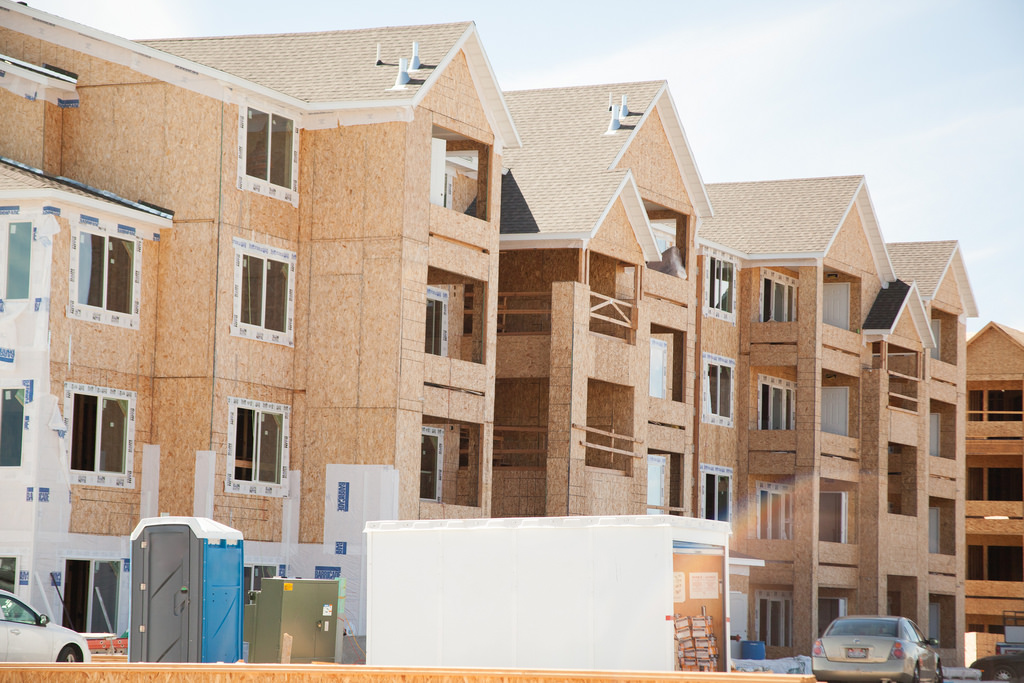Predictions that multifamily housing construction would taper off in 2015 may have underestimated the ongoing demand for this kind of housing, the vast majority of which is being marketed as rentals.
Seasonally adjusted annualized starts for structures with five or more units rose to 476,000 in June, an 18-year high, according to Commerce Department estimates released a few days ago. That number was 28.6% higher than the annualized multifamily starts rate in May, and 55% higher than the comparable number in June 2014.
Perhaps more significant is the fact that multifamily continues to propel most of the housing sector’s current growth. While annualized single-family starts in June, at 685,000 units, were 14.7% ahead of June 2014, they actually declined by 0.9% compared to May 2015.
“The multifamily gains this month are encouraging and show that the millennial generation continues to be drawn to the rental market,” said Tom Woods, a home builder from Blue Springs, Mo., who is chairman of the National Home Builders Association (NAHB).
All told, the year-over-year annualized rate for all starts was up 26.6% in June to 1,174,000 units.
The NAHB/Wells Fargo Housing Market Index, which tracks Builder Confidence levels, hit 60 in July. The Index also revised its June level to 60. The last time this Index got this high was November 2005.
If permit activity is a gauge of future optimism about demand, builders remain solidly behind multifamily. The annualized rate in June for permits issued for structures five or more units was up 79% to 621,000 units, compared to June 2014. Single-family permits, on the other hand, were up 6% to 687,000, according to Commerce’s estimates. All told, annualized new-home building permits jumped 30% to 1,343,000.
The latest annualized data show that 500,000 structures with five or more units were under construction in June, 20.5% more than in June 2014; and 317,000 units were completed, a 17.9% gain.
David Crowe, NAHB’s chief economist, noted that while the starts and Builder Confidence numbers were positive signs, he cautioned that builders “still face a number of challenges, including shortages of lots and labor.”
Related Stories
MFPRO+ News | Jun 3, 2024
Seattle mayor wants to scale back energy code to spur more housing construction
Seattle’s mayor recently proposed that the city scale back a scheduled revamping of its building energy code to help boost housing production. The proposal would halt an update to the city’s multifamily and commercial building energy code that is scheduled to take effect later this year.
Resiliency | Jun 3, 2024
Houston’s buyout program has prevented flood damage but many more homes at risk
Recent flooding in Houston has increased focus on a 30-year-old program to buy out some of the area’s most vulnerable homes. Storms dropped 23 inches of rain on parts of southeast Texas, leading to thousands of homes being flooded in low-lying neighborhoods around Houston.
MFPRO+ New Projects | May 29, 2024
Two San Francisco multifamily high rises install onsite water recycling systems
Two high-rise apartment buildings in San Francisco have installed onsite water recycling systems that will reuse a total of 3.9 million gallons of wastewater annually. The recycled water will be used for toilet flushing, cooling towers, and landscape irrigation to significantly reduce water usage in both buildings.
MFPRO+ News | May 28, 2024
ENERGY STAR NextGen Certification for New Homes and Apartments launched
The U.S. Environmental Protection Agency recently launched ENERGY STAR NextGen Certified Homes and Apartments, a voluntary certification program for new residential buildings. The program will increase national energy and emissions savings by accelerating the building industry’s adoption of advanced, energy-efficient technologies, according to an EPA news release.
MFPRO+ News | May 24, 2024
Austin, Texas, outlaws windowless bedrooms
Austin, Texas will no longer allow developers to build windowless bedrooms. For at least two decades, the city had permitted developers to build thousands of windowless bedrooms.
Mass Timber | May 22, 2024
3 mass timber architecture innovations
As mass timber construction evolves from the first decade of projects, we're finding an increasing variety of mass timber solutions. Here are three primary examples.
Mixed-Use | May 22, 2024
Multifamily properties above ground-floor grocers continue to see positive rental premiums
Optimizing land usage is becoming an even bigger priority for developers. In some city centers, many large grocery stores sprawl across valuable land.
MFPRO+ News | May 21, 2024
Massachusetts governor launches advocacy group to push for more housing
Massachusetts’ Gov. Maura Healey and Lt. Gov. Kim Driscoll have taken the unusual step of setting up a nonprofit to advocate for pro-housing efforts at the local level. One Commonwealth Inc., will work to provide political and financial support for local housing initiatives, a key pillar of the governor’s agenda.
MFPRO+ News | May 21, 2024
Baker Barrios Architects announces new leadership roles for multifamily, healthcare design
Baker Barrios Architects announced two new additions to its leadership: Chris Powers, RA, AIA, NCARB, EDAC, as Associate Principal and Director (Healthcare); and Mark Kluemper, AIA, NCARB, as Associate Principal and Technical Director (Multifamily).
MFPRO+ News | May 20, 2024
Florida condo market roiled by structural safety standards law
A Florida law enacted after the Surfside condo tower collapse is causing turmoil in the condominium market. The law, which requires buildings to meet certain structural safety standards, is forcing condo associations to assess hefty fees to make repairs on older properties. In some cases, the cost per unit runs into six figures.

















